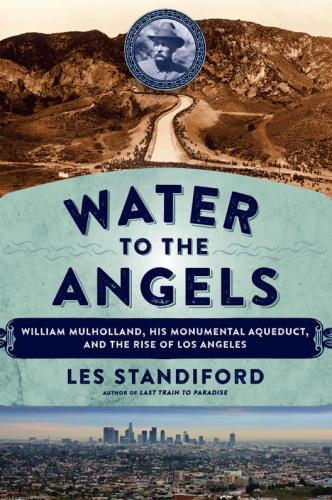
Water to the Angels
William Mulholland, His Monumental Aqueduct, and the Rise of Los Angeles
کتاب های مرتبط
- اطلاعات
- نقد و بررسی
- دیدگاه کاربران
نقد و بررسی

January 26, 2015
Standiford (Last Train to Paradise) takes on and defends (despite claims that the book is merely factual) the controversial and steadfast William Mulholland, who developed and oversaw the seemingly impossible construction of an aqueduct from Owens Valley to Los Angeles in the early 20th century. The development of a Los Angeles water system that enabled and responded to the city’s quick growth is deeply entwined with the politics of the era and allegations of corruption, though this book does not do the topic justice. Standiford admits this is “not a work of traditional scholarship,” but something he chose to do for the sake of the general reader. Yet the book is confusingly organized, with a tangential, but attention-grabbing, first chapter (which features a dam that broke, flooding a valley and killing hundreds at the end of Mulholland’s career); unusual juxtaposition of anecdotes; and an overall conflict in its premise—is it a biography of Mulholland or the story of the aqueduct? Pacing is also unfortunate, as the book lags in its unnecessarily long description of the building of the aqueduct and doesn’t pick up again until the end. What could have been an intensely interesting affair unfortunately lacks detail richness and fails to cohere.

February 15, 2015
Standiford (creative writing, Florida International Univ.; Last Train to Paradise) offers a biography of William Mulholland (1855-1935), focusing on his role in the development of Los Angeles. While the author provides factual details regarding the California Water Wars and the collapse of the St. Francis Dam, which often cast Mulholland in a poor light, his desire to avoid a condemnation of his subject means that his language ultimately leans a bit too much toward the apologetic. For example, in the first 30 pages alone, Mulholland is referred to as "legendary" multiple times and the author's note describes an incident when the subject's granddaughter was harassed, indicating that the reader should feel sympathetic toward the granddaughter...and her grandfather by extension. In describing the collapse of the St. Francis Dam, which resulted in hundreds of deaths and millions of dollars in damages, Standiford describes how Mulholland willingly took blame for the incident, which the reader should consider refreshing because modern-day politicians wouldn't have done the same. The author tries to humanize Mulholland, a man who made great things happen--for both good and ill, depending on one's point of view. VERDICT This work might appeal to those interested in the American West, California, water rights, and biography. However, readers wanting a more balanced perspective should consider Mark Reisner's Cadillac Desert. [See Prepub Alert, 9/14/14.]--Crystal Goldman, Univ. of California, San Diego Lib.
Copyright 2015 Library Journal, LLC Used with permission.

























دیدگاه کاربران